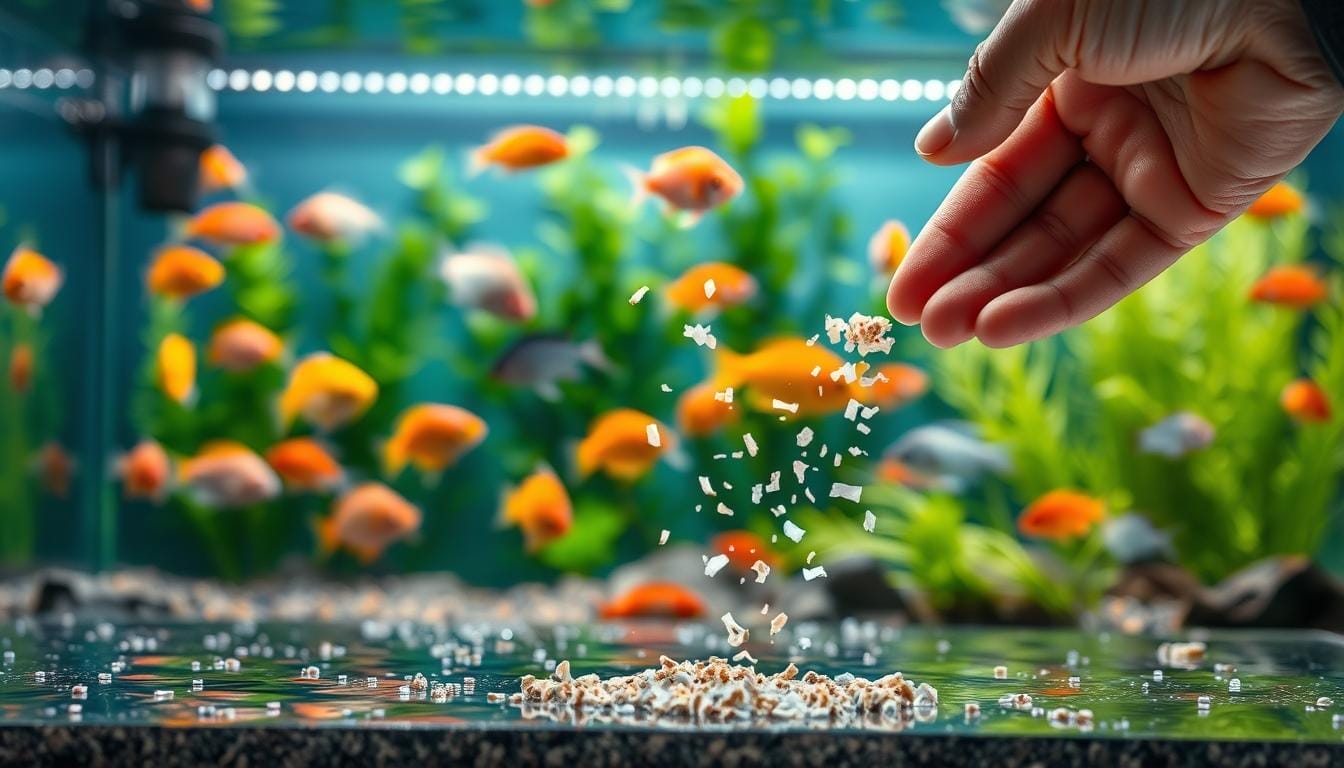
Best Nano Tank Equipment for Thriving Aquariums
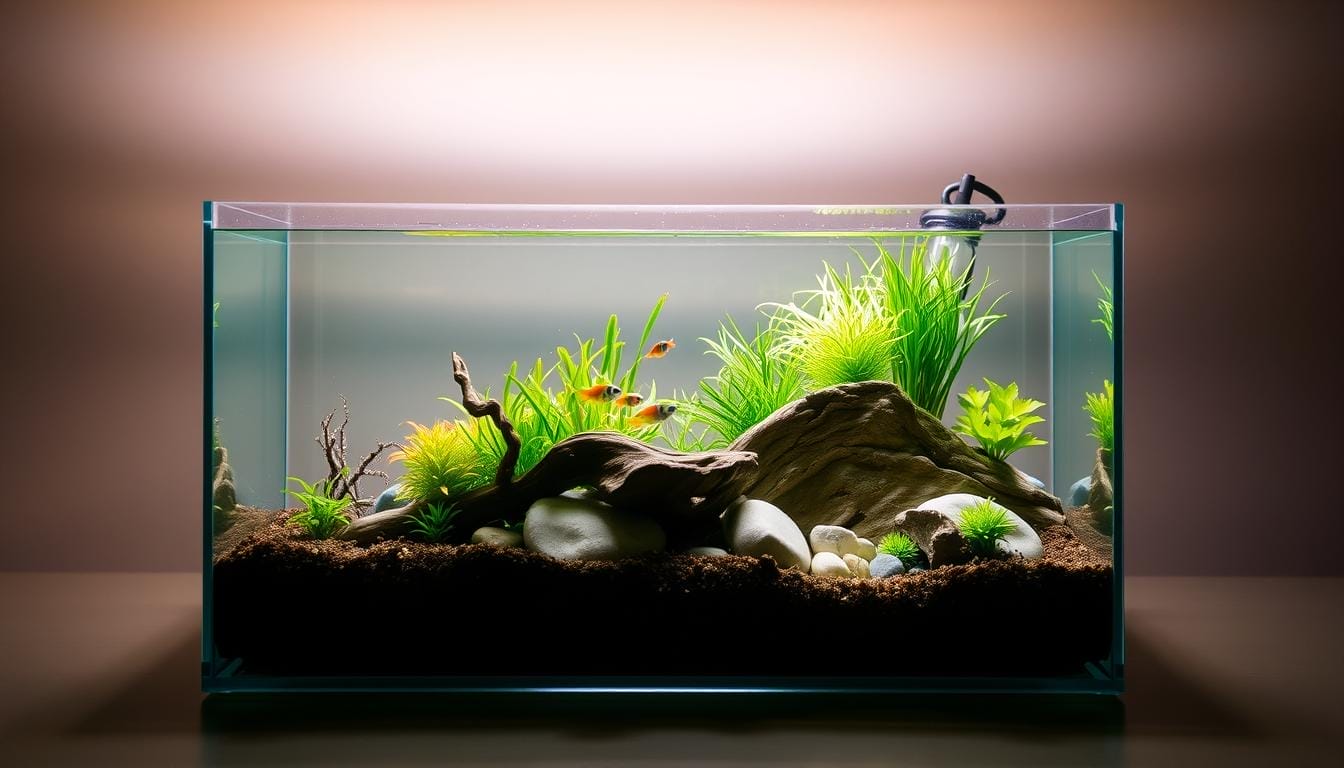
Did you know a thriving underwater world can exist in just 5 gallons of water? Compact aquatic setups have surged in popularity, with over 40% of urban hobbyists now choosing small-scale systems for their homes. These miniature ecosystems prove that size doesn’t limit beauty—when you have the right tools.
Creating a healthy environment for aquatic life in limited space requires precision. Proper filtration and lighting aren’t just accessories—they’re lifelines for your plants and fish. Modern advancements let you achieve crystal-clear water and vibrant growth even in the coziest corners of your living space.
This guide simplifies the process of building your dream aquatic display. You’ll learn how to balance form and function while avoiding common pitfalls. Whether you’re new to the hobby or refining your skills, we’ll help you select components that work seamlessly together.
Discover how thoughtful design choices elevate your setup from basic to breathtaking. By focusing on quality over quantity, you’ll create a self-sustaining habitat that captivates everyone who sees it. Let’s dive into the essentials that make compact aquariums not just survive, but truly flourish.
Introduction to Nano Aquarium Concepts
Urban dwellers are discovering the joys of miniature underwater gardens. These compact setups let you nurture aquatic life without sacrificing precious room in apartments or offices. Their rising popularity stems from clever design and accessibility—perfect for anyone craving nature’s calm in tight spaces.
Defining Compact Water Worlds
Small-scale aquatic systems typically hold 5-24 gallons, fitting neatly on desks or shelves. Unlike bulky alternatives, they arrive ready-to-use with integrated filters and lights. This plug-and-play approach removes guesswork, letting you focus on creative layouts rather than technical setup.
Mastering Miniature Ecosystems
Successful small aquariums demand careful planning. Water quality shifts faster in limited volumes, making consistent care crucial. Our step-by-step method helps you avoid common mistakes while building a balanced environment. You’ll learn to maintain crystal-clear water and thriving plants through simple, effective routines.
Modern designs blend style with practicality, offering sleek profiles that complement any decor. From shrimp habitats to planted masterpieces, these systems prove big wonders come in small packages. Their affordability and low maintenance make aquatic hobbies achievable for busy lifestyles.
Understanding Nano Tanks and Their Benefits
Living in a bustling city doesn’t mean sacrificing your love for aquatic beauty. Compact water habitats solve the space puzzle while delivering serene visual escapes. Their growing popularity stems from clever adaptations to modern lifestyles—where efficiency meets elegance.
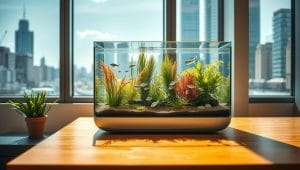
Why Small-Scale Solutions Shine in Cities
Space-saving designs transform cramped apartments into tranquil oases. A 10-gallon setup fits perfectly on kitchen counters, office desks, or narrow shelves. Unlike bulky alternatives, these systems blend into your decor rather than dominating it.
Startup costs for compact habitats often run 60% lower than larger counterparts. You’ll save on:
- Energy bills (LED lights sip power)
- Water treatments (smaller volumes)
- Decor elements (fewer materials needed)
Weekly maintenance becomes manageable—a 20% water change takes minutes instead of hours. But remember: smaller volumes demand consistent care. Test water parameters twice weekly to protect delicate species.
These miniature worlds offer surprising versatility. Create lush planted scenes or vibrant coral displays without overwhelming your living area. Their calming presence reduces stress, proving good things do come in small packages.
Essential Nano Tank Equipment for a Thriving Aquarium
Creating a self-sustaining aquatic habitat in limited space requires precision tools designed for micro-environments. Specialized components work like clockwork to maintain water clarity, temperature stability, and biological balance—factors that make or break your underwater oasis.
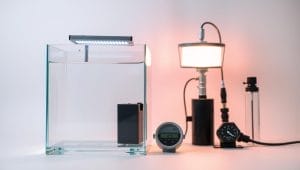
Building Blocks of Success
Every thriving setup relies on four core elements working in harmony:
- Filtration systems that handle waste without overpowering delicate inhabitants
- Compact pumps creating gentle flow patterns
- Temperature controllers maintaining ±1°F accuracy
- Full-spectrum LEDs promoting plant growth
Manufacturers now produce space-saving versions of traditional aquarium gear. These scaled-down solutions nestle discreetly behind panels or under substrates, preserving your layout’s clean aesthetic. Always match component sizes to your aquarium’s dimensions—oversized filters can stress shrimp, while undersized heaters struggle in colder rooms.
Saltwater systems demand extra attention to water chemistry. Consider adding mini protein skimmers or media reactors if housing corals. Freshwater plant enthusiasts should prioritize adjustable lighting schedules. Invest in quality parts from trusted brands—they’ll outperform bargain-bin alternatives while fitting seamlessly into tight spaces.
Smart automation transforms maintenance routines. Timers for lights and feeders, plus app-connected monitors, let you enjoy your aquatic masterpiece rather than constantly tweaking settings. Remember: proper planning prevents frantic midnight equipment swaps when something fails.
Nano Tank Filtration Options and Equipment
Filtration is the unsung hero of every healthy aquatic environment. Your compact setup relies on two silent warriors working together: mechanical and biological systems. These partners tackle visible debris and invisible threats, keeping your underwater world safe.
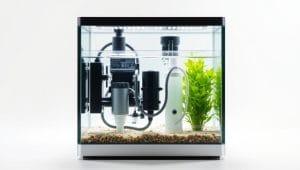
Mechanical vs. Biological Filtration
Mechanical filtration acts like a net, catching floating particles. Sponges trap fish waste and leftover food before they decay. This first line of defense prevents cloudy water and maintains clarity.
Biological filtration hosts microscopic allies. Beneficial bacteria (Nitrobacter and Nitrosomonas) colonize porous media. They transform toxic ammonia from waste into safer nitrates. K1 media and ceramic rings offer perfect bacterial apartments with their textured surfaces.
Choosing the Right Filter for Your Setup
Match your filter’s flow rate to your aquarium’s size. Too strong currents stress small swimmers, while weak flow leaves debris circulating. Consider these popular media types:
- Bio-balls for high oxygen zones
- Ceramic noodles for dense bacterial colonies
- Fine sponges for dual mechanical/biological action
Regular maintenance keeps your system efficient. Rinse mechanical media in tank water during freshwater fish tank setup changes to preserve bacteria. Upgrade components gradually as your aquatic community grows, ensuring stable water parameters through every growth phase.
Innovative Lighting Solutions for Nano Aquariums
Lighting isn’t just visibility—it’s life support for your underwater world. The right glow fuels photosynthesis, enhances colors, and keeps delicate species thriving. Modern solutions balance intensity with precision, turning compact displays into radiant focal points.
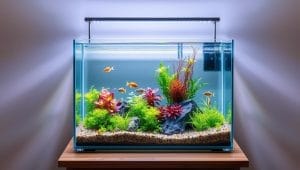
Smart LED Technology Saves Energy
Today’s LED systems like the EcoTech Marine RADION XR15W G4 PRO pack serious power into slim designs. Their HEI Optics deliver full-spectrum light that mimics natural sunlight, perfect for coral growth. Three standout benefits:
- 45% less energy than traditional bulbs
- Cooling fans prevent heat buildup
- Customizable color blends for visual drama
This system’s airflow design disperses warmth efficiently—critical in small setups where temperature swings stress inhabitants. You’ll see richer reds in Ludwigia plants and deeper blues in Acropora corals without risking your aquatic friends.
Timing Is Everything
Consistency matters more than raw power. CoralLab’s SPS AB+ template simplifies scheduling—just set it at 80% intensity. Why dial it back? Lower settings:
- Prevent algae overgrowth
- Save electricity
- Extend bulb lifespan
Mount lights 6-8 inches above water for even coverage. Pair morning ramps with sunset dimming to mimic natural cycles. Your fish will display brighter colors, and plants will grow bushier under these stable conditions.
Water Management and Daily Changes in Nano Tanks
Balancing water parameters in compact habitats requires smart daily routines. Small volumes magnify even minor fluctuations, making consistency your greatest ally. Through strategic care, you’ll create a stable environment where delicate species flourish.
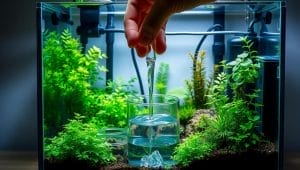
Efficient Water Change Techniques
Frequent, partial replacements outperform weekly overhauls in small systems. For a 16-gallon setup, swap 0.7 gallons daily or 5 gallons weekly—this 4%/30% rule prevents shock while removing waste. Use a marked bucket for precise measurements and temperature-matched blends.
Premium salt mixes like RedSea Sea Salt Blue Bucket ensure proper mineral balance. Follow these steps for stress-free changes:
- Test parameters before replacing water
- Mix new saltwater 24 hours in advance
- Use a siphon to vacuum debris during removal
Automate your routine with compact pumps and digital reminders. Pair changes with effective nano aquarium maintenance checks—monitor temperature, salinity, and pH simultaneously. This integrated approach saves time while safeguarding your aquatic community.
Consistency trumps quantity. Smaller, daily adjustments mimic natural tidal patterns, reducing stress on inhabitants. Your fish will display brighter colors, and corals will extend polyps more readily in this stable environment.
Pumps and Water Flow Essentials for Nano Aquariums
Imagine your aquatic friends dancing in gentle currents that mimic their natural habitat. Proper water movement does more than create visual appeal—it delivers life-sustaining oxygen and nutrients while whisking away harmful waste. Getting this balance right transforms your setup from static to sensational.
Finding Your Flow Partner
The AQAMAI Powerhead stands out for small-space success. Its compact design fits discreetly behind rocks while generating customizable patterns. Run it in RANDOM MODE at full power to prevent dead zones where debris collects. For saltwater enthusiasts following our nano-reef setup guide, the Mighty Jet Desktop DC Return Pump offers silent operation with adjustable flow rates.
Smart Circulation Strategies
Aim for 20-30 times your system’s volume in hourly flow. A 10-gallon setup needs 200-300 gallons per hour total movement. Achieve this by:
- Positioning pumps at opposite ends
- Angling outputs toward surface agitation
- Using timers to simulate tidal changes
Upgrade to the EcoTech MP10QD when corals outgrow initial spaces. Its wireless control lets you fine-tune flow without disturbing your layout. Remember: gentle pulsing often works better than constant blasts for delicate species.
Clean pump intakes monthly using a soft brush—clogged impellers reduce efficiency. Pair regular maintenance with flow checks to keep your miniature ecosystem thriving. When done right, your aquatic residents will reward you with vibrant colors and active behaviors.
Integrating Skimmers and Media Reactors in Nano Tanks
Advanced water purification tools can transform your compact aquatic environment. Specialized devices work behind the scenes to maintain pristine conditions, letting you enjoy vibrant aquatic life without constant upkeep. These systems tackle invisible threats while preserving your carefully crafted aesthetic.
Benefits of Protein Skimmers in Small Systems
Protein skimmers act like microscopic trash collectors. They pull organic waste from the water column before it decays, reducing harmful nutrient spikes. In confined spaces, this prevention-focused approach keeps parameters stable with minimal effort.
Modern models designed for tight spaces offer three key advantages:
1. Oxygen boost: Foam fractionation increases gas exchange, vital for fish and coral health.
2. Space efficiency: Slim profiles tuck neatly behind rocks or equipment panels.
3. Customizable operation: Adjust collection cups to match your tank’s bioload.
Pair skimmers with mini media reactors for complete water polishing. These compact units circulate water through specialized filter media, targeting specific issues like phosphate buildup. Together, they create a self-regulating system that handles challenges before they impact your aquatic friends.
FAQ
Why are compact aquatic systems popular for city dwellers?
Their space-saving design fits perfectly in apartments while maintaining a vibrant underwater world. With proper equipment like the Fluval Spec V, you can create stable environments for fish and corals without sacrificing style.
What essentials do I need for a successful small aquarium?
Start with a quality filter (AquaClear works well), precise heater, full-spectrum LED light, and testing kits. Add live rock for biological filtration and algae scrapers for glass clarity. Always use marine-specific salt mixes for saltwater setups.
How do I choose the right filter for a 5-gallon setup?
Prioritize adjustable flow pumps like the EcoTech Vortex or Tunze Nano. Match filtration capacity to your tank’s bioload – hang-on-back filters combine mechanical and biological media efficiently in tight spaces.
Are LED lights sufficient for growing corals?
Absolutely! Modern LEDs like the Kessil A160WE provide customizable spectrums and intensity. Start with 8-hour daily cycles, gradually increasing to 12 hours while monitoring coral response.
How often should I refresh water in a 10-gallon reef?
Replace 10-20% weekly using temperature-matched saltwater. Tools like the Python No-Spill System make this effortless. Always test salinity (1.023-1.025 SG) before adding new water.
What pump works best for seahorses or delicate species?
Use adjustable circulation pumps like the Tunze Nanostream 6040. Their gentle flow modes prevent stress while maintaining proper oxygenation. Position outputs to avoid direct currents on sensitive creatures.
Do protein skimmers function effectively in 15-gallon systems?
Yes! Compact models like the Innovative Marine Ghost Skimmer efficiently remove organic waste. Pair them with carbon reactors for crystal-clear water in reef environments.
Can I use treated tap water instead of RO/DI?
While possible using conditioners like Seachem Prime, reverse osmosis water is safer long-term. Tap water often contains phosphates and nitrates that fuel algae in confined spaces.
How do I maintain stable parameters between water changes?
Test weekly using Salifert or Red Sea kits. Automated systems like the AutoAqua Smart AWC handle partial changes daily, keeping calcium, alkalinity, and pH steady.
What fish thrive in 3-gallon freshwater environments?
Focus on nano species – ember tetras, least killifish, or shrimp colonies. Avoid active swimmers; instead, create vertical interest with moss walls and floating plants like dwarf water lettuce.





